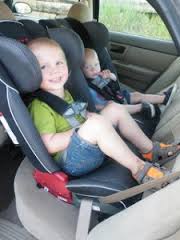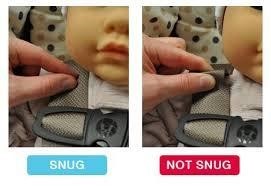Did you know – Road trauma is the leading cause of death for Australian children up to 14.
You can however keep your children safer from harm by having properly installed restraints and correctly using your car and booster seats in your car. And before you roll your eyes and say, “Yeah, yeah I know all this already I have 4 kids” know this: Various studies have shown that even for parents who are on their third or even fourth child, car seat use and installation is one of the few things that people tend not to get better at.
Correct installation and ongoing use can be a matter of life and death – so please sit down and read.
- Keep children rear facing for as long as possible
Turning from rear or forward facing is not a milestone that you should be excited to meet. Forward facing is far more dangerous full stop. Its not like walking or saying their first words.Once your child outgrows their baby capsule or baby carseat (which are always rear facing) then you’re ready to move them to a convertible carseat. There’s no reason why that seat needs to be forward facing. There are plenty of seats on the market that allow extended rear facing. Legally children can forward face at 6 months of age. But “can” and “should” are two different things. You should always keep your child rear facing until they reach the rear-facing limits of their convertible seat. With most modern seats that will happen from around 18 months old to 2 years plus.
A common misconception we hear from parents is that they are concerned that their child’s legs will be squashed or in a dangerous position while rear facing. The fact is that children are actually at greater risk for leg injuries when they are forward facing in the car because in an accident, their feet make contact with the seat in front of them, which is simultaneously moving backward. Yep – in an accident – everything moves. The result is a compression injury, something that doesn’t happen when the child is rear-facing.
- Keep the car seat straps firm
You may have noticed a little label on your carseat or capsule that says “A loose harness is dangerous”. That’s the truth. We see lots of people who are worried about having the straps firm on their baby in the seat but please make sure that yours are nice and tight. In the event of an accident a loose harness can be ineffective and can allow a child to fly forward very fast. You don’t want them to “jump into” the harness in an accident but rather to stay where they are in their restraint nice and safe. The best way to check is the pinch test -when the harness is done up on your child can you pinch it? If not then its tight enough. - Use the top tether
We have been surprised sometimes by customers handing us the top tether strap from their capsule and saying they didn’t bother using it because it was annoying. Please don’t be this person. The top tether is a vital part of the restraint system and it decreases how far the child and the restraint will move in an accident by a great many cms. - Don’t start using a Booster too soon
A booster seat is really just a seatbelt positioning device – its purpose is to position the child so that the car seatbelt can be safely used and the belts will remain in a safe position on the child’s body. The lap section should remain low on the thighs (not on the tummy) and be completely flat and the shoulder belts need to be across the chest and rest between the child’s neck and shoulder. A lap belt that is on the tummy can cause life-altering injuries to the spinal cord and internal organs. - Don’t stop using a Booster too soon
Again, legally kids can stop using a booster when they’re 7 years of age. But “can” doesn’t equal “should”. Our simple 5 step test can help you decide whether or not your child is ready to stop using their booster:- Can the child sit with their back against the vehicle seat back?
- Do the child’s knees bend in front of the edge of the seat?
- Does the sash belt sit across the middle of the shoulder?
- Is the lap belt sitting low across the hips touching the thighs?
- Can the child stay seated like this for the whole trip?
- Check your restraint daily
Once you’ve been and had your seat professionally installed the responsibility to ensure its used safely every time is up to you. We give our customers a checklist of things to check daily and weekly post-installation so that they know how to safely use their restraint once they’ve gone home.Some of the daily checks we suggest include:- Is the car seatbelt still buckled up (*you can’t imagine how many times we’ve seen carseats that have been unbuckled by a toddler and no one knew for months!)- Are the shoulder straps free of twists (twists in the shoulder straps can cause very nasty bruising and more)
- Is there any slack in the top tether?
- Are there any loose items in the vehicle that could become a missile in an accident?
Weekly checks we suggest:- Is the child too heavy for this restraint now?
- Is the child too tall for this restraint now?- Are the child’s shoulders above the shoulder slots? Do they need an adjustment?
- Use the dedicated Child Restraint Anchor Points in your car
If you’re installing your seat yourself, check your vehicle’s manufacturer manual that came with the car and be sure that you’re tethering the restraint to an anchor point and not a luggage tie down instead. In some cars it can be really confusing working out what is what so always refer to your car manual or an accredited restraint fitter to confirm that you’ve anchored the restraint to the right point. If not there is a chance that in an accident the anchor won’t hold and the child will fly into the seat in front face first. - Check with CREP
Surprisingly our most popular baby capsule for hire in 2013 was also the unsafest capsule on the market. The product shall remain nameless but that goes to show the power of marketing. Baby capsules aren’t a fashion symbol but a safety device so its best to choose one that has the best safety rating and put looks down the list of must-haves. Thankfully the highest rating products are often really affordable too being locally made and manufactured. You can get all the ratings information from Child Car Seats.Child Car Seats is an initiative of the Child Restraint Evaluation Program (CREP), a consortium of government agencies and motorist organisations who aims to provide consumers with information to help choose safe child car seats and to apply pressure on car seat manufacturers to only market seats that perform well beyond the Australian Standard.
- How tight is tight enough?
For many parents, the idea that the seat be installed the tighter it can go the better. For many reasons including the engineering that goes into the restraints and crash dynamics this is somewhat untrue and can cause unnecessary anxiety. Despite a common opinion, pushing on a restraint particularly at the end that it is not attached to the car, and pushing it with your hand from side to side to see if it moves is not a valid test and may only loosen the seatbelt’s relationship with the restraint leaving it requiring reinstallation. Going by the Australian Standards, engineering and testing processes a restraint does not have to be ‘rock solid’ to be safe. As long as the restraint is fitted to the manufacturer’s specifications and the restraint is not moving more than an 1 inch at the belt path area it is in fact fine. - Don’t text or talk while driving
Don’t. Whatever it is can wait, or you can pull over, grab a cold drink and do your texting then return, safely to the road. Your children are relying on you to safely transport them wherever you’re going and these days there’s plenty of distractions on the road without taking your eyes off it to have a chat on the phone.


